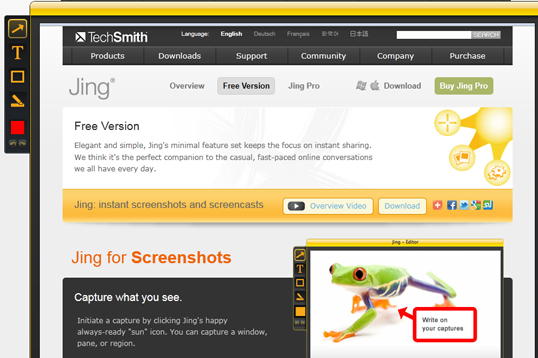JING
Homepage: http://www.techsmith.com/jing/
Tool Category/ies: Communication Creativity Innovation
License Type: Free + Pay Options
Overall Rating
4/5
Jing is a tool that captures images or animations on your computer with your own voice narratives. Once captured, The images or videos can be available instantly on the Web if the user sends them through either screencast.com or saves them locally and uploads to the website, like your blog site.
Other Tool Types
View All Tools
Rating: 4/5
Reviewed by: Kye on 06/07/2011
Applications of this compact, but capable tool are boundless. You may use Jing to insert a simple visual information such as a map into an instant messaging conversation, an email as a link (url), and even a Word document or powerpoint presentation. But, the most compelling use of Jing should be where an instant image or video information is needed at the moment of ongoing conversation or collaboration on the Web. Jing's website aptly describes it as "Snap a picture of your screen, record video of onscreen action, and share instantly over the web, IM, email."
I have quite a unique teaching style in college mathematics teaching. In most courses, my students need to present their mathematical work (either problem solving or proof) to the whole class. This particular technique is very powerful because the students' attitude toward their work is very different when they think they have to explain what they understood to the whole class in front of the teacher. They reflect upon their work relentlessly until they really make sure they got it.
However, it had some drawbacks in the past. Some (but not often) students simply cannot explain math in front of his/her peers and the teacher. So I had to let them do it in my office privately, which is very time consuming. Also, I usually have many students in my office during the office hours because some students want to rehearse their presentations before class. Jing has a great potential to remedy this situation. Some shy students may create a Jing document before their presentation and make it available to the teacher or to their group. This Jing document with images and voices could mimic what they would do during their presentations. The student in the same group may rehearse their presentations with Jing documents before class one another, which can save many hours of teacher's time. Extremely shy students now create Jing presentations for his/her teacher for grade. I admit some students either dropped the class or changed the section because of mandatory presentation requirement. With Jing, I have now an alternative.
Another use of Jing in a teaching environment is online tutoring. One difficulty of online (math) tutoring is the context in which the question arises. When a student asks a question online, he/she has to explain the whole context just to explain what the question is. This usually wouldn't be a problem in face-to-face to tutoring environment with textbooks and other materials available. If students are taking an online course, this issue of context is even more problematic because tutors often times do not have access to the web page the student is looking at. In this scenario, Jing can help greatly in that student can simply capture the question and its context, and insert his/her questions with arrows and text boxes onto any form of online tutoring - either email, IM, or web. Then, the tutor can return the Jing document with hints or suggestions. This exchange can continue until the student can get enough help they need.
What are the advantages of using this tool in a teaching environment?
Jing generalizes the notion of a document that the students and a teacher communicate by. With the documents created by pencil and paper, the students and a teacher used to exchange textual and visual information efficiently in the form of homework and projects. In digital era, the students and a teacher were able to exchange textual information efficiently, but not images and videos. With Jing, the students and a teacher can now exchange information not only in terms of text and images, but also in terms of videos. For example, the teacher may read homework document submitted in any form, document or image, then insert comment on their work with Jing and return their work. The use of videos in presenting their work or projects that can be captured in their computer screens opens up a fascinating possibility in many academic learning and evaluating situations.
What are the disadvantages of using this tool in a teaching environment
The reliability of information could be an issue. Images and videos are not reliable as textual documents. They may be easily corrupt during transfer. It also requires bigger data, which implies more Internet bandwidth for such data exchanges. It also requires more care to create images and videos, even with Jing.
©2011- The University of Houston. All rights reserved.
4800 Calhoun Road, Houston, Texas 77204 (713) 743-2255

